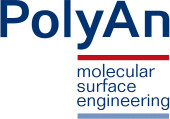각종 샘플(세포, 조직, 환경샘플 등)로부터 고품질
DNA나 RNA를 가장 쉽고 빠르게 뽑을 수 있습니다.
이 외에도, 각종 Epigenetics 관련 제품들
(DNA Methylation kit 등)과 Microbiomics
(샘플 채집부터 분석까지의 전 단계의 제품)
연관 제품들이 준비되어 있습니다.
제품정보
Kyongshin PRODUCT

제품소개
PolyAn’s carboxy-microparticles (COOH) are functionalised using our proprietary Molecular Surface Engineering (MSE) Technology. PolyAn’s 3D-Carboxy matrix is suitable as a platform for a wide range of coupling methods. Our microparticles are characterised by low non-specific adsorption and low aggregation behaviour.
While we publish an overview of our products, it is by no means comprehensive. If the particle you require is not listed, we urge you to contact us to check our complete inventory. Please note, that we also offer a customization service for your specific application.
주문정보
| CAT.No | 품명 | 규격 | 비고 |
|---|---|---|---|
| 106 50 003 | Fluorescent Microparticles (beads, microspheres) | PolyAn Red4 | 3.5µm, 3D-Carboxy PolyAn Red4 Multiplex Beads, 8 populations (peaks) |
| 106 50 005 | Fluorescent Microparticles (beads, microspheres) | PolyAn Red4 | 5µm, 3D-Carboxy PolyAn Red4 Multiplex Beads, 10 populations (peaks) |
| 106 50 009 | Fluorescent Microparticles (beads, microspheres) | PolyAn Red4 | 8.5µm, 3D-Carboxy PolyAn Red4 Multiplex Beads, 7 populations (peaks) |
| 106 51 003 | Fluorescent Microparticles (beads, microspheres) | PolyAn Red4 | 3.5µm, 3D-Alkyne PolyAn Red4 Multiplex Beads, 8 populations (peaks) |
| 106 51 005 | Fluorescent Microparticles (beads, microspheres) | PolyAn Red4 | 5µm, 3D-Alkyne PolyAn Red4 Multiplex Beads, 10 populations (peaks) |
| 106 51 009 | Fluorescent Microparticles (beads, microspheres) | PolyAn Red4 | 8.5µm, 3D-Alkyne PolyAn Red4 Multiplex Beads, 7 populations (peaks) |
| 106 52 003 | Fluorescent Microparticles (beads, microspheres) | PolyAn Red4 | 3.5µm, Streptavidin PolyAn Red4 Multiplex Beads, 8 populations (peaks) |
| 106 52 005 | Fluorescent Microparticles (beads, microspheres) | PolyAn Red4 | 5µm, Streptavidin PolyAn Red4 Multiplex Beads, 10 populations (peaks) |
| 106 52 009 | Fluorescent Microparticles (beads, microspheres) | PolyAn Red4 | 8.5µm, Streptavidin PolyAn Red4 Multiplex Beads, 7 populations (peaks) |
| 106 53 003 | Fluorescent Microparticles (beads, microspheres) | PolyAn Red4 | 3.5µm, Neutravidin PolyAn Red4 Multiplex Beads, 8 populations (peaks) |
| 106 53 005 | Fluorescent Microparticles (beads, microspheres) | PolyAn Red4 | 5µm, Neutravidin PolyAn Red4 Multiplex Beads, 10 populations (peaks) |
| 106 53 009 | Fluorescent Microparticles (beads, microspheres) | PolyAn Red4 | 8.5µm, Neutravidin PolyAn Red4 Multiplex Beads, 7 populations (peaks) |
| 106 54 003 | Fluorescent Microparticles (beads, microspheres) | PolyAn Red4 | 3.5µm, 3D-Aldehyde PolyAn Red4 Multiplex Beads, 8 populations (peaks) |
| 106 54 005 | Fluorescent Microparticles (beads, microspheres) | PolyAn Red4 | 5µm, 3D-Aldehyde PolyAn Red4 Multiplex Beads, 10 populations (peaks) |
| 106 54 009 | Fluorescent Microparticles (beads, microspheres) | PolyAn Red4 | 8.5µm, 3D-Aldehyde PolyAn Red4 Multiplex Beads, 7 populations (peaks) |
| 106 55 003 | Fluorescent Microparticles (beads, microspheres) | PolyAn Red4 | 3.5µm, 3D-Azide PolyAn Red4 Multiplex Beads, 8 populations (peaks) |
| 106 55 005 | Fluorescent Microparticles (beads, microspheres) | PolyAn Red4 | 5µm, 3D-Azide PolyAn Red4 Multiplex Beads, 10 populations (peaks) |
| 106 55 009 | Fluorescent Microparticles (beads, microspheres) | PolyAn Red4 | 8.5µm, 3D-Azide PolyAn Red4 Multiplex Beads, 7 populations (peaks) |
| 106 56 003 | Fluorescent Microparticles (beads, microspheres) | PolyAn Red4 | 3.5µm, Protein A/G PolyAn Red4 Multiplex Beads, 8 populations (peaks) |
| 106 56 005 | Fluorescent Microparticles (beads, microspheres) | PolyAn Red4 | 5µm, Protein A/G PolyAn Red4 Multiplex Beads, 10 populations (peaks) |
| 106 56 009 | Fluorescent Microparticles (beads, microspheres) | PolyAn Red4 | 8.5µm, Protein A/G PolyAn Red4 Multiplex Beads, 7 populations (peaks) |